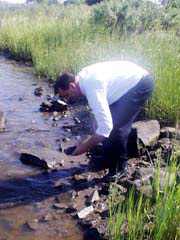When the Lenape Indians wandered the shores of the Hackensack and Passaic rivers, they didn’t have to hunt far for oysters. Both rivers as well as many of the other area wetlands had plenty, and historians claim to have found oyster shells as big as dinner plates wherever the Native American Indians once camped.
These oysters didn’t vanish after Europeans came on the scene, although frequent harvesting diminished their size. But in the mid-19th Century, someone claimed to have found a pearl in an oyster on the Passaic River. A rush for riches nearly equal to the California gold rush began from which the oyster population never recovered. This was followed a short time later by the industrial development that eventually destroyed what oysters remained.
In 1997, local officials sought to change all this. In an experiment conducted by the New York/New Jersey Baykeeper – funded by grants from the Pew Charitable Trust and the Victoria Foundation, people began to seed the Hackensack River as well as other area water ways with oysters.
Richard Dwyer, a spokesperson for the environmental preservation arm of PSE&G, said that there are a few differences between then and now. For one thing, the Hackensack River itself has changed.
“Until the 1920s, the Hackensack River was a fresh water river,” Dwyer said. “But then the Oradell Dam was built.” At that point the river became a tidal river and salt water washed through areas where the oysters once resided.
“So we aren’t exactly restoring things to the way they were,” Dwyer said. “But the fact that they are coming back is a good sign.”
Oysters help restore oxygen to the water and remove sediment and pollution.
“Oysters are little bio-engineers,” Dwyer said. “What they do is take the silt and pollution out of the water. In their digestive process, they make little packets and dispose them on the bottom. The crabs come along and eat the packets. So all the stuff that is free flowing in the water gets processed. Each oyster can process up to 50 gallons of water a day.”
Dwyer noted that scientists studying decreases in the water quality in the Chesapeake Bay found a direct correlation between lack of oysters and a drop in water quality.
Since then, people like Dwyer and others have come out to the waterside to check on the progress. Last year, environmentalists discovered that their work had progressed, with fresh beds of oysters found near Laurel Hill Park in Secaucus.
“What we’re doing is looking to where they are and how many we can find,” Dwyer said. “We’re looking on the Secaucus side as well as the Kearny side of the river. We’re hoping for the oysters to regenerate to make the water quality better. This will allow for more fish and the more fish you get the more ospreys and other birds that will come here to feed.” Sidebar:
New Jersey Meadowlands Commission Secures Tidal Wetlands For Preservation
In a continuing effort to implement Governor McGreevey’s Smart Growth initiative and secure sensitive wetlands in the Meadowlands district, the New Jersey Meadowlands Commissioners are expected on Thursday, Oct. 23 to approve of the acquisition of 170 acres of tidal mudflats and marshes for preservation.
“This is a very significant step forward in protecting these sensitive wetlands areas and the wildlife that call them home – including the many migratory birds that move through the Meadowlands District in the fall as they head south for the winter,” said NJMC Chairman Susan Bass Levin. “This acreage increases the growing number of wildlife habitats that we have preserved during this Administration and protects them for the enjoyment of future generations.”
The areas slated for preservation include 97.06 acres in the Saw Mill Creek Tidal Basin of Lyndhurst and 72.1 acres of wetlands in Kearny.
The land proposed for acquisition in Lyndhurst is predominantly made up of mud flats on the west side of the Saw Mill Creek Trail.
The mud flats support vast numbers of microscopic plants that produce large amounts of oxygen. The oxygen is distributed throughout the Meadowlands tidal system leading some people to call the area “the lungs of the Hackensack River.”
When water levels are high, the basin is home to striped bass and white perch, which feed on gizzard shad, menhaden, silversides and mummichogs. Snapper bluefish, weakfish, and carp also use the basin. There are also grass shrimp in the spartina grass and reedy areas on the fringes of the basin.
Osprey, terns, herons, egrets, cormorants and mergansers all hunt the fish in the basin. A wide range of ducks feed on the mudflats, and they are in turn preyed upon by peregrine falcons and bald eagles. Thousands of shorebirds feed on the mudflats as well.
The Kearny wetlands, in the Cayuga Dike region, are part of a large wetland system, which functions as an important wintering feeding grounds for a variety of waterfowl including gadwalls, northern shovelers, and mergansers.
“This is another step in our plan to acquire 8,400 acres of open space, wetlands, and waterways for a Meadowlands preserve,” said NJMC Executive Director Bob Ceberio. “It’s good to know that future generations will be able to enjoy this ecological oasis.”
